Numerical Investigation on Electromagnetic Scattering Characteristics of Circulation Control Wing Surface
Abstract
:1. Introduction
2. Computational Models and Numerical Methods
3. Results and Discussion
3.1. The Electromagnetic Scattering Characteristics of Basic Carrier
3.2. The Electromagnetic Scattering Characteristics of Rudder Carrier
3.3. The Electromagnetic Scattering Characteristics of CC-Wing
3.3.1. Static Scattering Characterization
3.3.2. Dynamic Scattering Characterization
4. Conclusions
- (1)
- The rudder movable gap of the traditional mechanical rudder surface primarily enhances the VV polarisation RCS of the wing. Conversely, the use of the circulation control technology can reduce the front RCS level of the wing, with a more pronounced reduction observed for the HH polarisation RCS at high frequency and the VV polarisation RCS at low frequency.
- (2)
- The Coanda surface utilised in the circulation control alters the contour of the trailing edge of the wing, which will consequently exert a detrimental influence on the rearward RCS level of the wing. In addition, the cavity structure of the high-pressure air source of the jet system will result in an increase in the front and back RCS levels of the wing. However, the back RCS level can be reduced by employing a bevelled design of the jet nozzle.
- (3)
- In the dynamic process of aircraft attitude adjustment, the circulation control technology can significantly reduce the front and side RCS levels of the wing in comparison to the wing that realises attitude control through rudders deflection. Furthermore, it can improve the issue of large differences in side RCS levels caused by wing roll and reduce the fluctuation of RCS levels in the dynamic process.
Author Contributions
Funding
Data Availability Statement
Conflicts of Interest
References
- Kohin, M. Scatter reducing step: Theory and measurements. IEEE Trans. Antennas Propag. 1996, 44, 896–901. [Google Scholar] [CrossRef]
- Sang, J.H. Aircraft Stealth Technology; Aviation Industry Press: Beijing, China, 2015. [Google Scholar]
- Shi, C.G.; Dong, J.; Zhou, J.J.; Wang, F. Overview of aircraft radio frequency stealth technology. Syst. Eng. Electron. 2021, 43, 1452–1467. [Google Scholar]
- Ji, J.Z.; Huang, P.L.; Ma, Y.P.; Zhang, S.J. Stealth Principle; Beihang University Press: Beijing, China, 2018. [Google Scholar]
- Miller, D.N.; Williams, D.; Warsop, C.; Smith, D.R. NATO AVT-239 task group: Approach to assess prospects of active flow control on a next-gen tailless aircraft. In Proceedings of the AIAA SCITECH 2019 Forum, San Diego, CA, USA, 7–11 January 2019. [Google Scholar]
- Hoholis, G.; Steijl, R.; Badcock, K. Circulation control as a roll effector for unmanned combat aerial vehicles. J. Aircr. 2016, 53, 1875–1889. [Google Scholar] [CrossRef]
- Warsop, C.; Crowther, W.J. Fluidic flow control effectors for flight control. AIAA J. 2018, 56, 3808–3824. [Google Scholar] [CrossRef]
- Wang, D.C.; Du, W.; Sun, J.H.; Liu, H. Numerical simulation of ground-effect wing with front engine blowing. In Proceedings of the 6th China Aeronautical Science and Technology Conference, Jiaxing, Zhejiang, China, 26–28 September 2023. [Google Scholar]
- Itsariyapinyo, P.; Sharma, R.N. Experimental study of a NACA0015 circulation control airfoil using synthetic jet actuation. AIAA J. 2022, 60, 1612–1629. [Google Scholar] [CrossRef]
- Li, Y.H.; Qin, N. Airfoil gust load alleviation by circulation control. Aerosp. Sci. Technol. 2020, 98, 105622. [Google Scholar] [CrossRef]
- Zhang, L.; Huang, Y.; Zhu, Z.L.; Gao, L.H. Virtual flight test of pitch and roll attitude control based on circulation control of tailless flying wing aircraft without rudder. Chin. J. Aeronaut. 2023, 36, 52–62. [Google Scholar] [CrossRef]
- Smith, D.; Dickey, E.; VonKlein, T. The ADVINT Program. In Proceedings of the 3rd AIAA Flow Control Conference, San Francisco, CA, USA, 5–8 June 2006; AIAA: Reston, VA, USA, 2006; pp. 2006–2854. [Google Scholar]
- Buonanno, A. Aerodynamic Circulation Control for Flapless Flight Control of an Unmanned Air Vehicle. Ph.D. Thesis, Cranfield University, Bedfordshire, UK, 2009. [Google Scholar]
- Fielding, J.P.; Mills, A.; Smith, H. Design and manufacture of the DEMON unmanned air vehicle demonstrator vehicle. Proc. Inst. Mech. Eng. Part G J. Aerosp. Eng. 2010, 224, 365–372. [Google Scholar] [CrossRef]
- Sun, Q.B.; Shi, Z.W.; Geng, X.; Wang, L.S.; Zhang, W.Y. Attitude control of flying wing aircraft without control surface based on active flow control. Acta Aeronaut. Astronaut. Sin. 2020, 41, 124080. [Google Scholar]
- Shao, S.; Guo, Z.; Jia, G.W.; Yin, P.; Hou, Z.X.; Zhang, L.P. Roll control study of flying wing based on trailing-edge jet at wide speed rang. J. Natl. Univ. Def. Technol. 2022, 44, 101–115. [Google Scholar]
- Jin, J.M.; Volakis, J.L. TE scattering by an inhomogeneously filled aperture in a thick conducting plane. IEEE Trans. Antennas Propag. 1990, 38, 1280–1286. [Google Scholar] [CrossRef]
- Gu, Y.R.; Chen, S.S.; Gao, Z.H.; Zhou, L. Investigations on electromagnetic scattering characteristics of aircraft rudder considering electromagnetic discontinuities. Proc. Inst. Mech. Eng. Part G J. Aerosp. Eng. 2023, 237, 3696–3708. [Google Scholar] [CrossRef]
- He, Y.B.; Yang, Q.Z.; Gao, X. Comprehensive optimization design of aerodynamic and electromagnetic scattering characteristics of serpentine nozzle. Chin. J. Aero. 2021, 34, 118–128. [Google Scholar] [CrossRef]
- Ma, R.B.; Ai, J.Q.; Cui, L.; Zhang, Y. Geometric modeling and electromagnetic scattering characteristics analysis of aircraft control surface slot. Telecomm. Eng. 2022, 62, 336–341. [Google Scholar]
- Zhang, W.R.; Ai, J.Q.; Wang, J. Electromagnetic scattering characteristics analysis of trailing edge of a trapezoidal wing. Telecomm. Eng. 2021, 61, 242–247. [Google Scholar]
- Allan, B.G.; Jones, G.S.; Lin, J.C. Reynolds-averaged Navier-Stokes simulation of a 2-D circulation control wind tunnel experiment. In Proceedings of the 49th AIAA Aerospace Sciences Meeting, Orlando, FL, USA, 4–7 January 2011. [Google Scholar]
- Englar, R.J.; Jones, G.S.; Allan, B.G.; Lin, J.C. 2-D circulation control airfoil benchmark experiments intended for CFD code validation. In Proceedings of the 47th AIAA Aerospace Sciences Meeting, Orlando, FL, USA, 5–8 January 2009. [Google Scholar]
- Song, J.; Lu, C.C.; Chew, W.C. Multilevel fast multipole algorithm for electromagnetic scattering by large complex objects. IEEE Trans. Antennas Propag. 1997, 45, 1488–1493. [Google Scholar] [CrossRef]
- Senior, T.B.A.; Volakis, J.L. Scattering by gaps and cracks. IEEE Trans. Antennas Propag. 1986, 37, 744–750. [Google Scholar] [CrossRef]
- Crispin, W.J., Jr.; Maffett, A.L. Estimating the radar cross section of a cavity. IEEE Trans. Aerosp. Electron. Syst. 1970, 6, 672–674. [Google Scholar] [CrossRef]
- Huang, P.; Liu, Z. Research on electromagnetic scattering characteristics of slits on aircraft. Acta Aeronaut. Astronaut. Sin. 2008, 29, 675–680. [Google Scholar]
- Sang, J.H.; Zhang, Z.B.; Wang, S. Research on the radar cross section of weak scatterers on stealth vehicle. Adv. Aeronaut. Sci. Eng. 2012, 3, 257–262. [Google Scholar]
- Yue, K. Static and Dynamic RCS Characteristics of Combat Aircraft; Beihang University Press: Beijing, China, 2016. [Google Scholar]

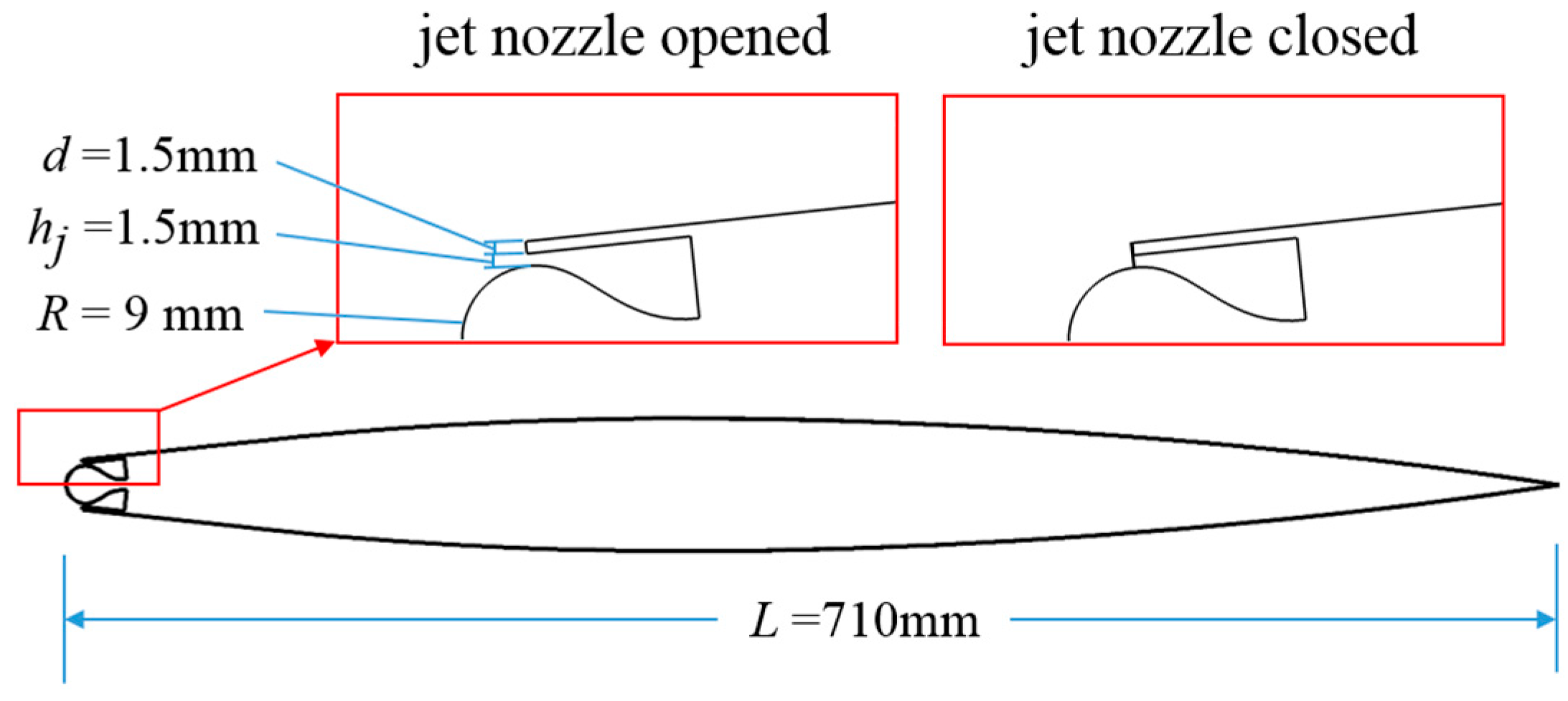
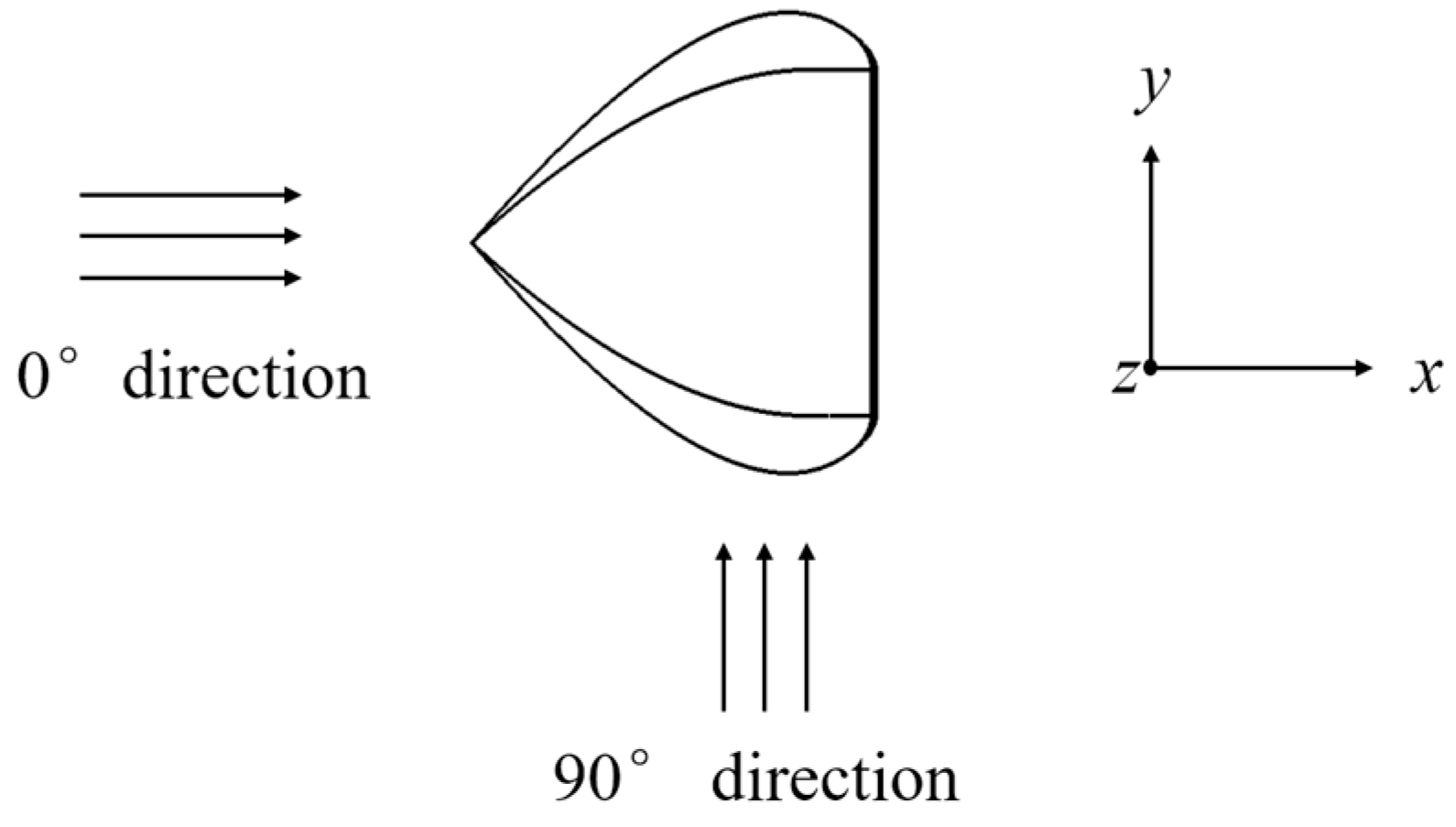
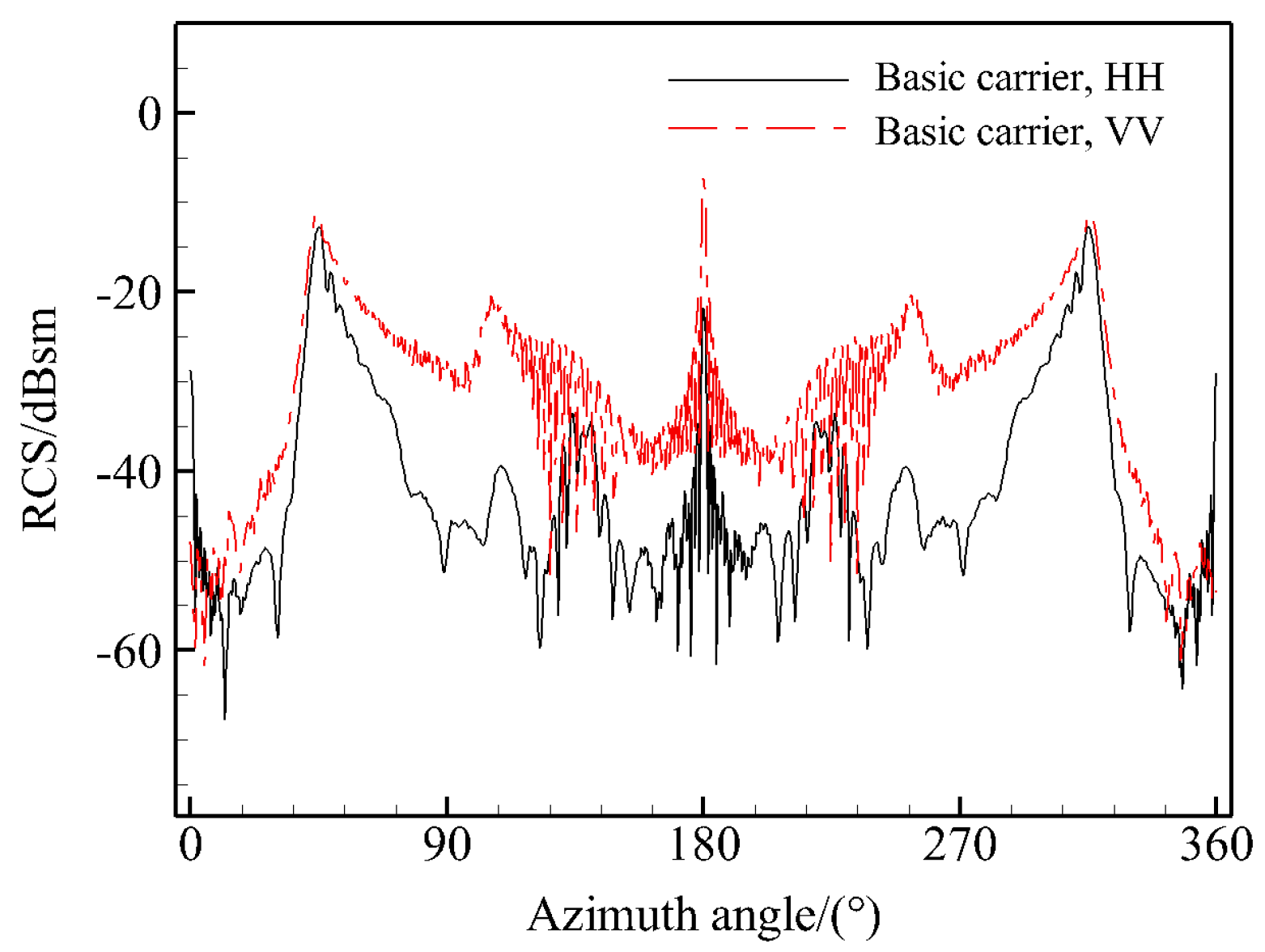
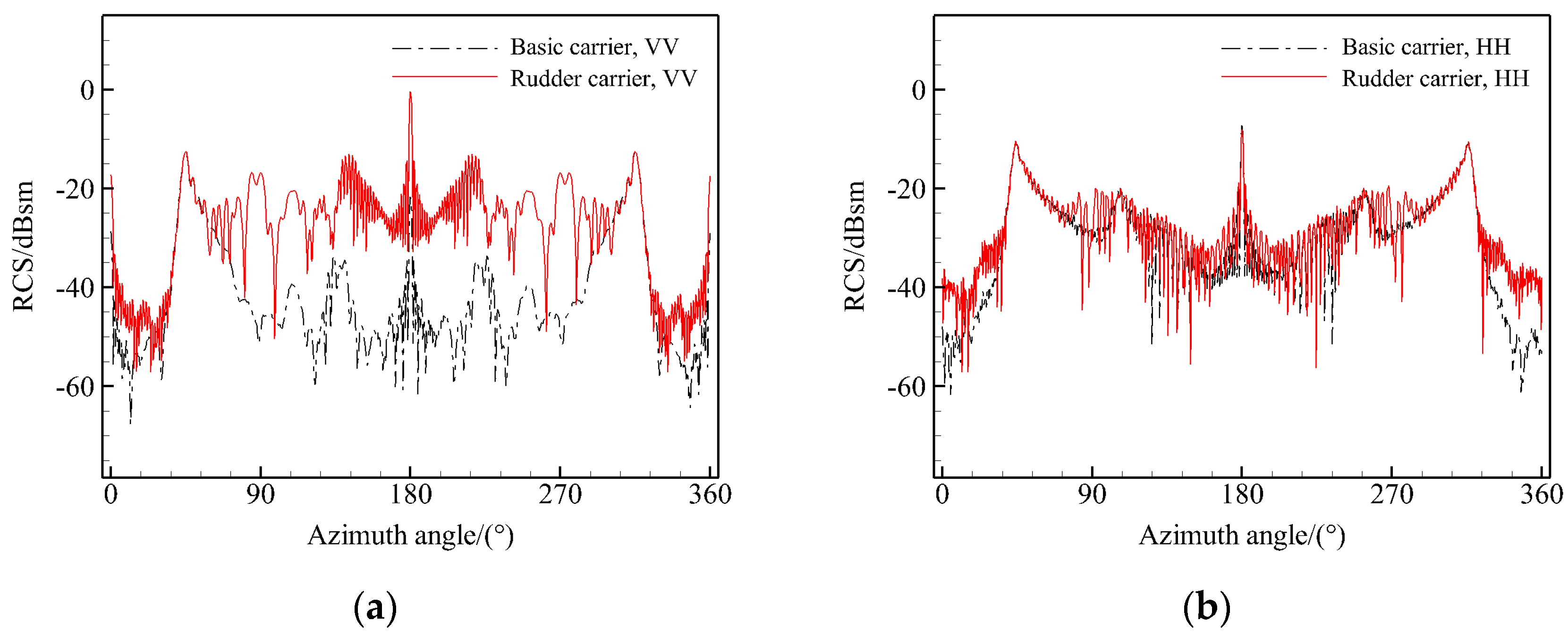
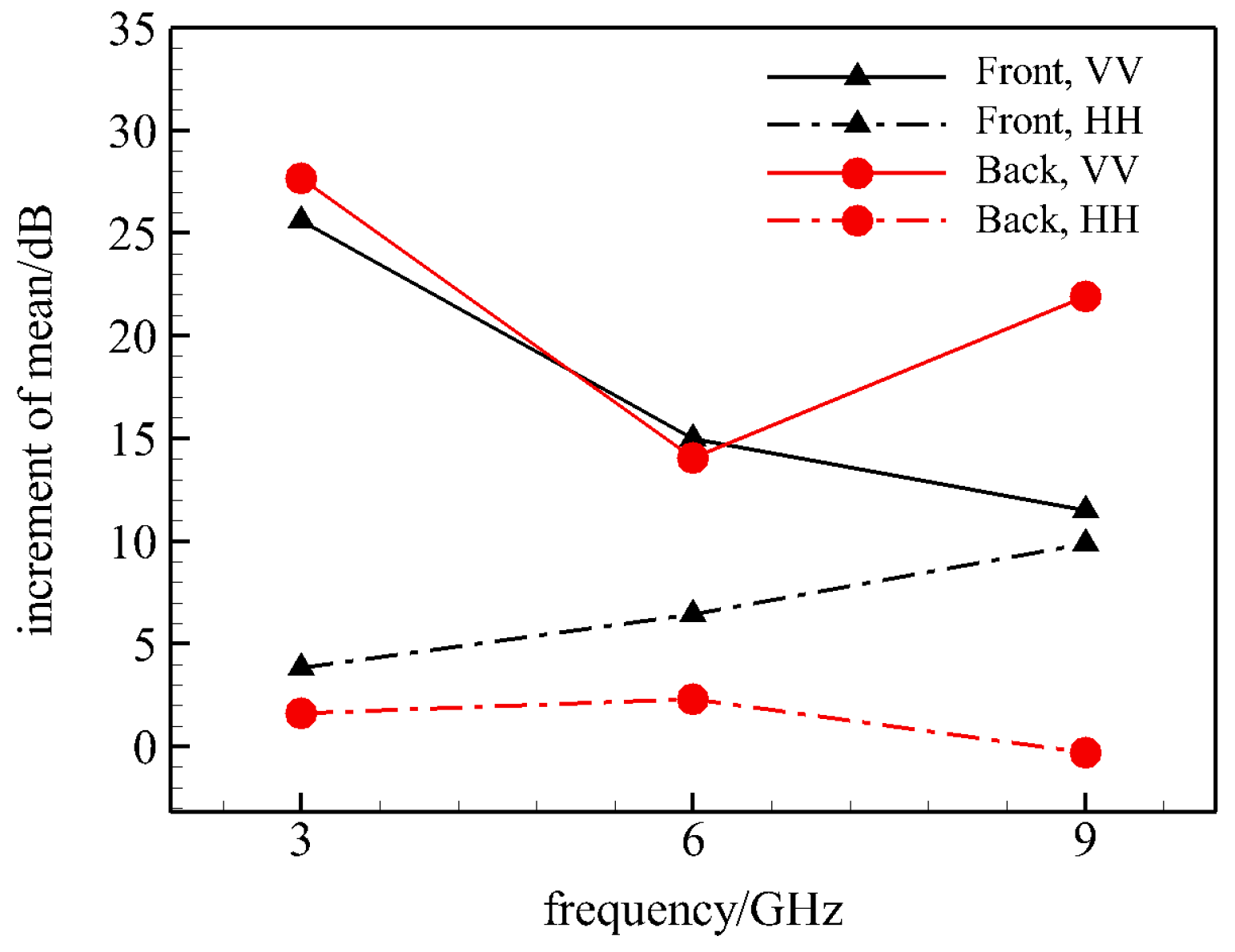

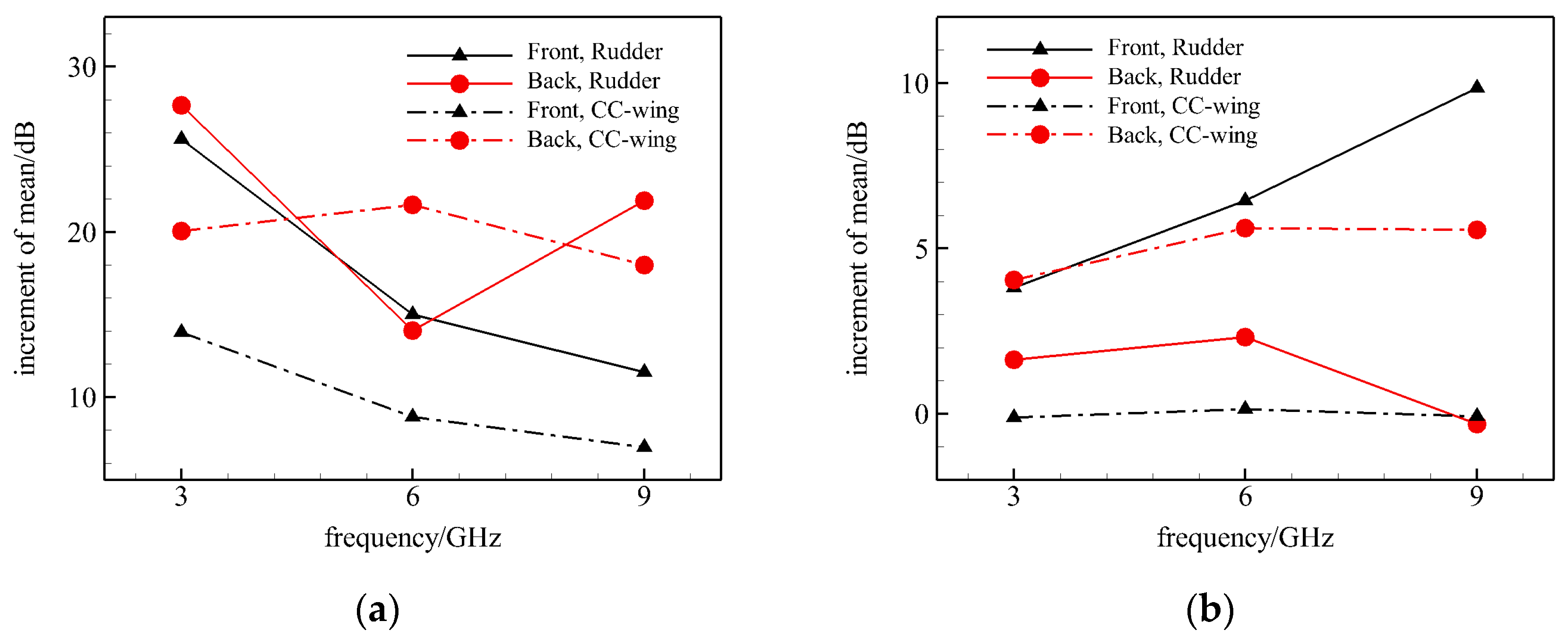

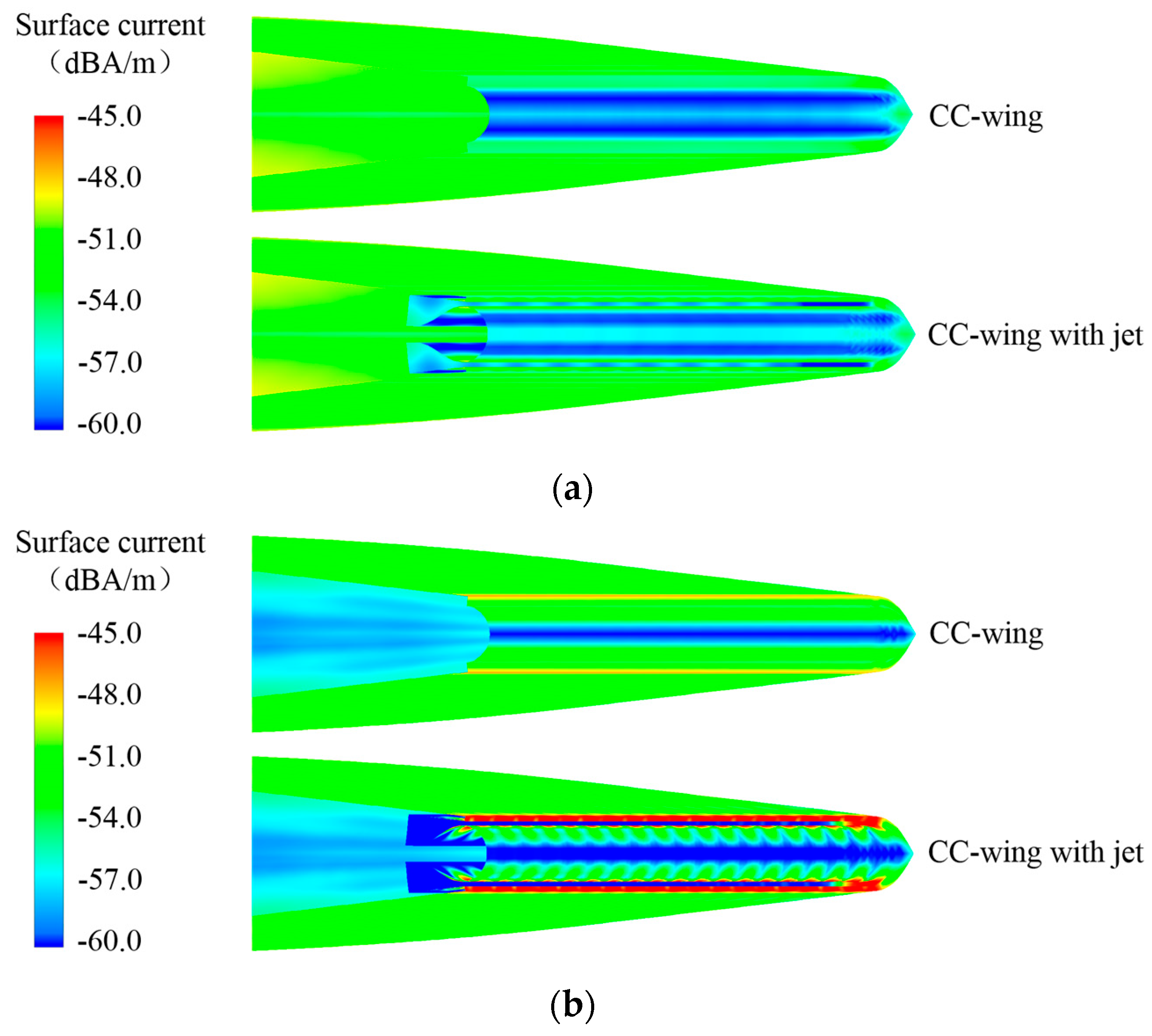


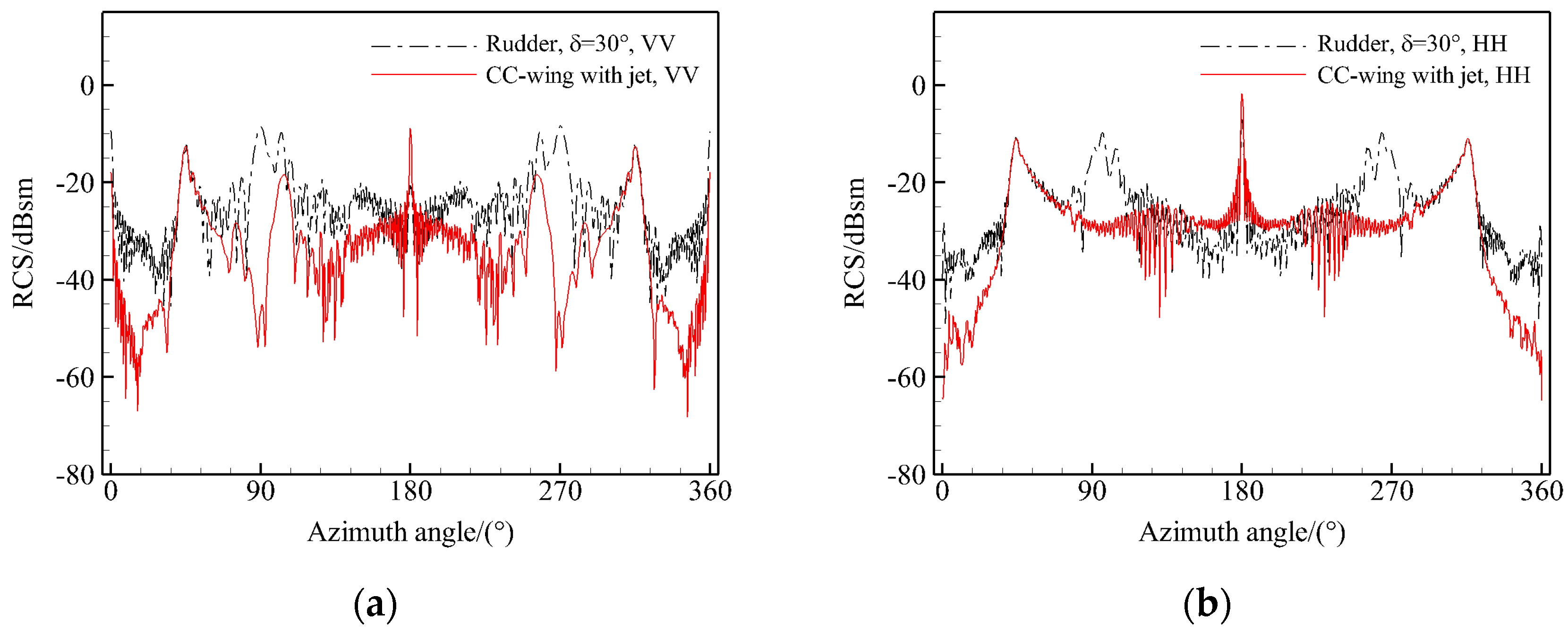

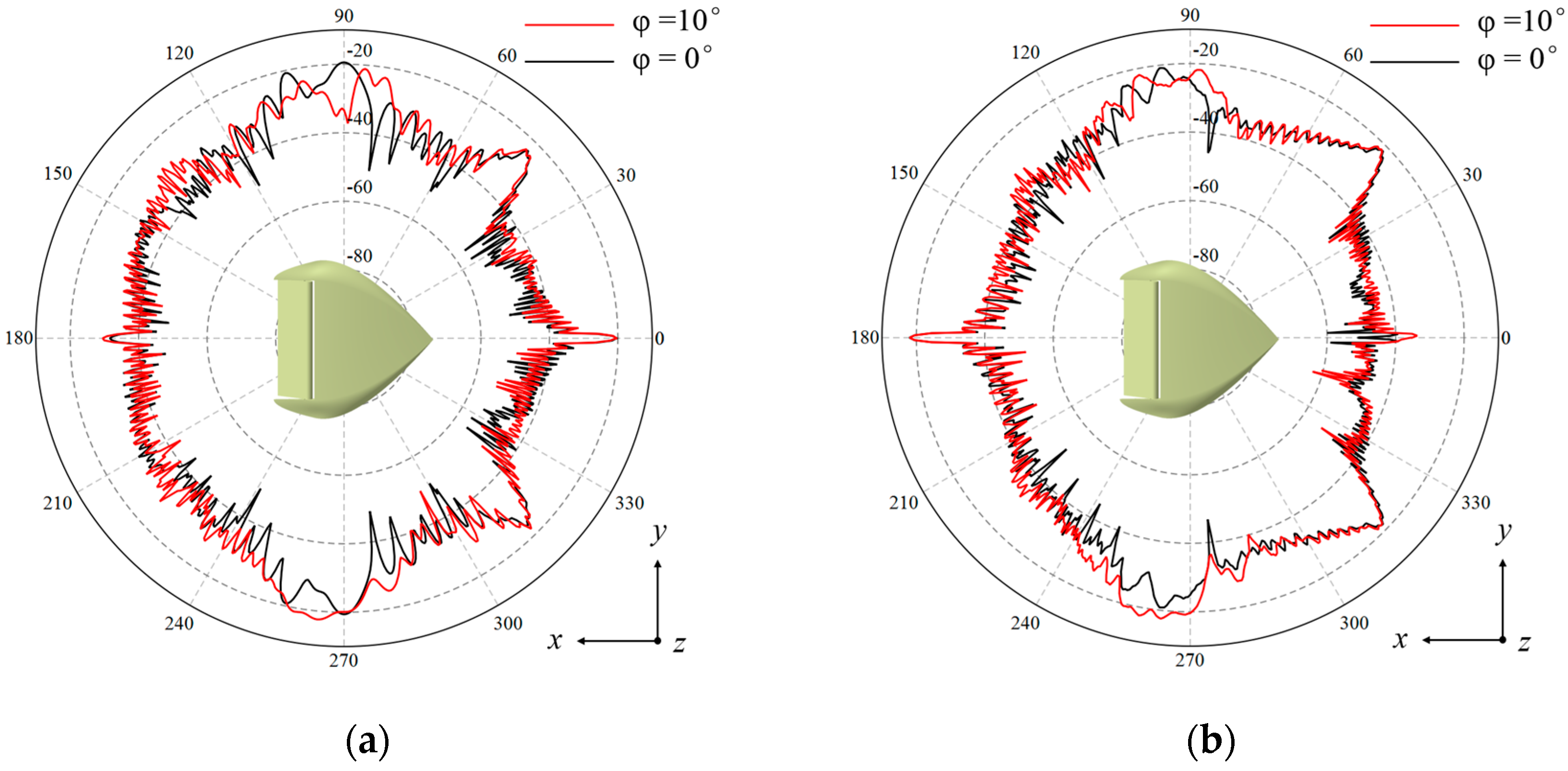
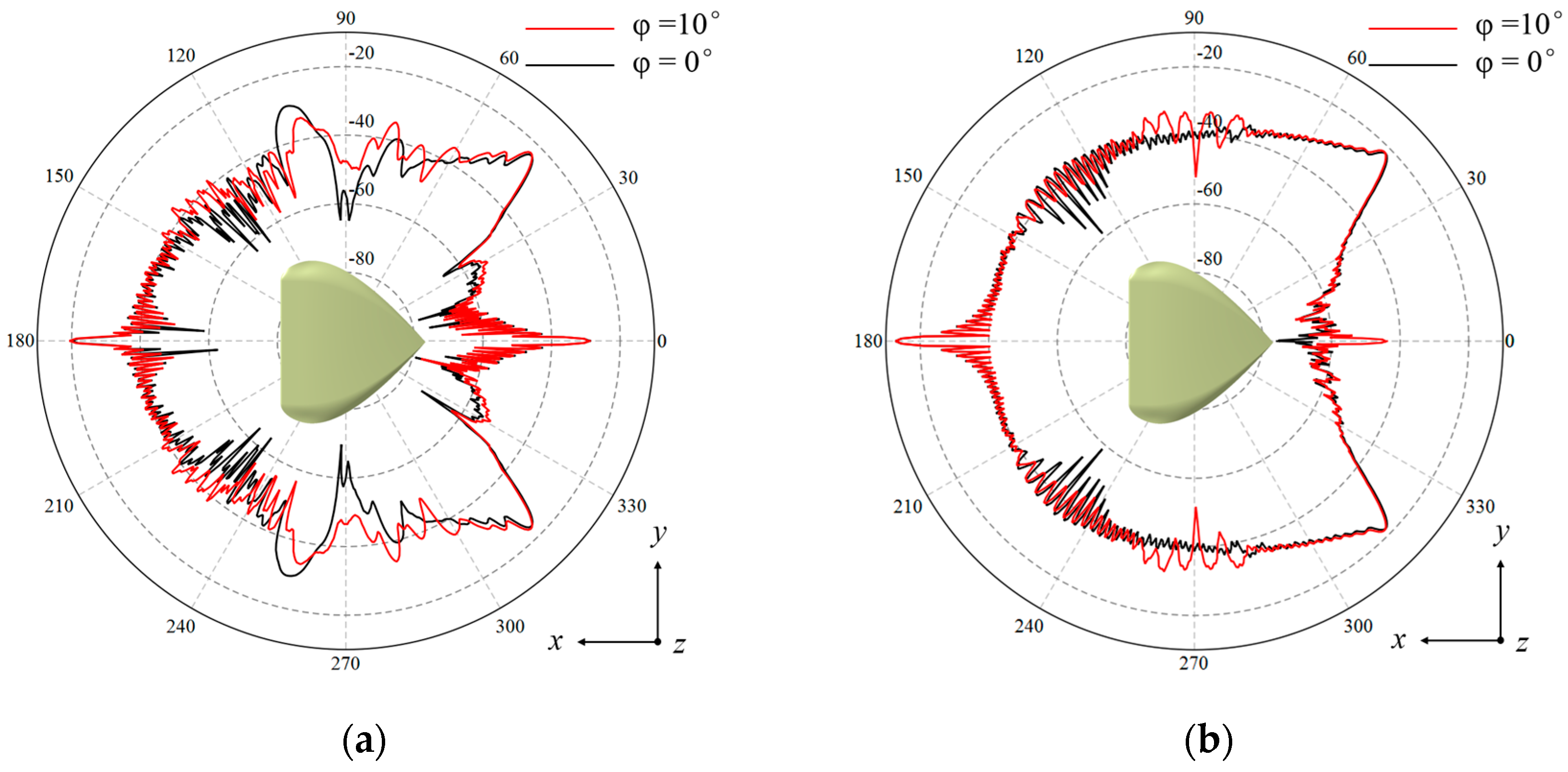
| Frequency/GHz | Polarize | RCS Mean Value/dBsm | ||
|---|---|---|---|---|
| Front ±30° | Back ±30° | Over 360° | ||
| 3 | VV | −41.58 | −39.99 | −24.69 |
| HH | −33.16 | −19.27 | −18.81 | |
| 6 | VV | −44.07 | −38.92 | −26.28 |
| HH | −40.71 | −21.97 | −21.24 | |
| 9 | VV | −43.48 | −37.71 | −27.59 |
| HH | −46.08 | −23.36 | −22.85 | |
| Frequency/GHz | Polarize | Mean Value Increment/dB | ||
|---|---|---|---|---|
| Front ±30° | Back ±30° | Side ±30° | ||
| 3 | VV | 1.93 | 1.18 | 0.75 |
| HH | 0.03 | −0.04 | 0.01 | |
| 6 | VV | 2.34 | 0.74 | 9.28 |
| HH | −0.65 | 0.01 | −0.13 | |
| 9 | VV | 3.85 | −4.42 | 10.83 |
| HH | −0.10 | 0.09 | 0.02 | |
| Model | Polarize | Mean Value Increment/dB | ||
|---|---|---|---|---|
| Front ±30° | Back ±30° | Side ±30° | ||
| rudder with = 15° | VV | 1.20 | −4.72 | 4.24 |
| HH | 1.00 | −1.00 | 2.84 | |
| rudder with = 30° | VV | 8.67 | −8.96 | 6.86 |
| HH | 2.05 | 1.27 | 6.30 | |
| CC-wing with jet | VV | −0.68 | −8.33 | −4.27 |
| HH | −10.04 | 5.95 | −2.76 | |
| Model | Polarize | Mean Value Increment/dB | |||
|---|---|---|---|---|---|
| Front ±30° | Back ±30° | Side ±30° (+y) | Side ±30° (−y) | ||
| rudder with = 15° | VV | 1.19 | 0.10 | 1.19 | 5.08 |
| HH | 1.20 | 0.26 | 1.20 | 3.18 | |
| rudder with = 30° | VV | 0.41 | 0.19 | −1.70 | 3.01 |
| HH | 2.11 | 0.10 | 0.76 | 4.76 | |
| CC-wing with jet | VV | −0.20 | 0.55 | −2.00 | −1.79 |
| HH | 2.19 | −0.04 | 1.66 | 1.61 | |
Disclaimer/Publisher’s Note: The statements, opinions and data contained in all publications are solely those of the individual author(s) and contributor(s) and not of MDPI and/or the editor(s). MDPI and/or the editor(s) disclaim responsibility for any injury to people or property resulting from any ideas, methods, instructions or products referred to in the content. |
© 2024 by the authors. Licensee MDPI, Basel, Switzerland. This article is an open access article distributed under the terms and conditions of the Creative Commons Attribution (CC BY) license (https://creativecommons.org/licenses/by/4.0/).
Share and Cite
Wang, D.; Cui, P.; Du, W.; Liu, H. Numerical Investigation on Electromagnetic Scattering Characteristics of Circulation Control Wing Surface. Aerospace 2024, 11, 781. https://doi.org/10.3390/aerospace11090781
Wang D, Cui P, Du W, Liu H. Numerical Investigation on Electromagnetic Scattering Characteristics of Circulation Control Wing Surface. Aerospace. 2024; 11(9):781. https://doi.org/10.3390/aerospace11090781
Chicago/Turabian StyleWang, Dechen, Peng Cui, Wei Du, and Hao Liu. 2024. "Numerical Investigation on Electromagnetic Scattering Characteristics of Circulation Control Wing Surface" Aerospace 11, no. 9: 781. https://doi.org/10.3390/aerospace11090781





